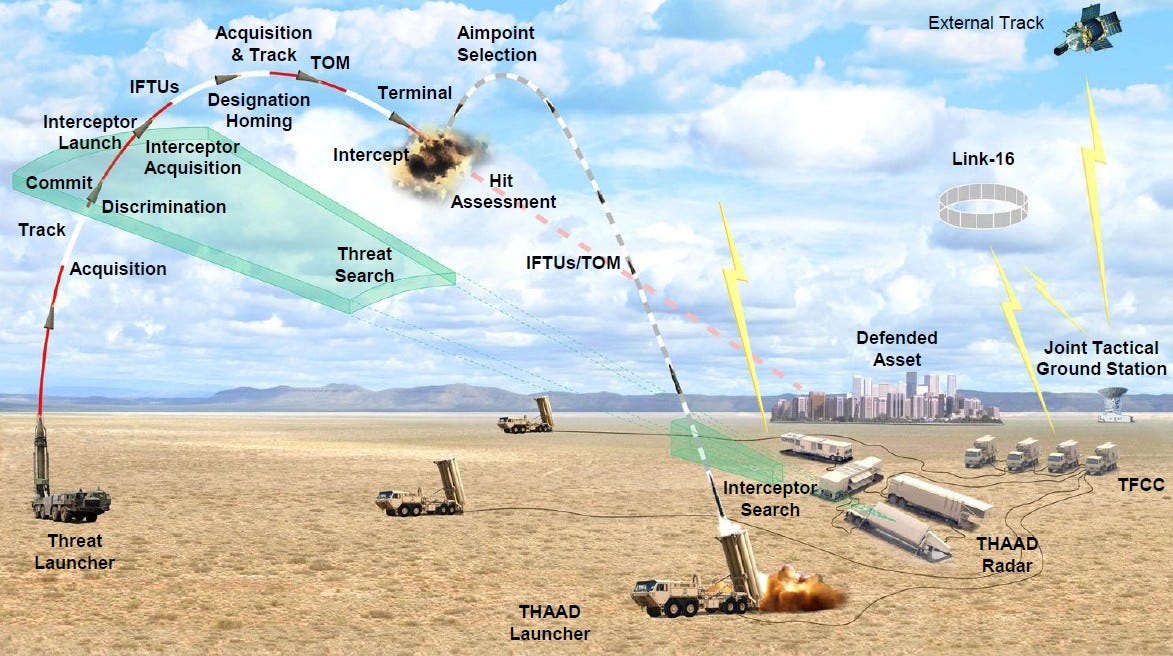The US is sending a THAAD missile battery to Israel, according to news reports.
A battery consists of six mobile launchers with eight interceptors of each, so 48 missiles manned by crew of 100 at a cost of close to $1 billion . The interceptors are “hittiles” meaning they do not have explosive warheads – they destroy a target by “hitting” — by kinetic energy alone.
The effective range is 150 to 200 km and the system seeks to acquire targets in their final or terminal phase. '
Each major component in the system makes use of GPS.
Think of THAAD, which was developed in the 199Os, as a more expensive Patriot system. And probably no more effective.
It certainly works against old-fashioned ballistic missiles like Scuds but who uses those any more if they can help it?
Against the newest generation of hypersonic missiles which travel at speeds between 8 and 20 mach, THAAD is likely out of its league.
Iran’s new Fattah missile, apparently seems to have been developed with Chinese hypersonic technology — which benefits from Russian experience with weapons of this kind: it has a terminal velocity of Mach 15 and is maneuverable in the terminal phase.
In any major strike, you can expect it to be used to take out THAAD radars and ground stations — and their American crews.
The Russian EW systems provided to Iran disable tje GPS networks used to operate the THAAD systems —as well as most Israeli AD systems. There ability was demonstrated in the recent missile strike.
Chinese cooperation with Iran has not been much in the news. But China has a a lot of new technology which it needs to test.
While Israel and the US dither about when and where to strike Iran, Iran continues to build up defenses. And no doubt is trying to import as much Russian and Chinese tech as it can.
At this point, it is unclear whether Russia has delivered its potent S400 systems to Iran, which already has the S300 and its own S400 equivalent, theBavar-373, which is designed to intercept 5th generation fighters such as the F22 and F35.
The Russian S400 was initially limited in its ability to intercept stealthy Storm Shadow missiles— and some early failures prompted a perfect storm of cackling putdowns of Russian technology.
So the Russians adapted. And updated the S400. Now the S400 handles Storm Shadow missiles handily— cruise missiles or not — stealth or not.
You can expect the Iranians have benefitted from those advances, incorporating them in S300s and Bavar 373s.
Of course, whatever AD system is used you need anti-stealth radars . And China has a new generation of anti-stealth tech.
China is reportedly eager to test these new systems and market them. Pakistan has already signed for the newest YL-C8E.
It’s very new, so the meantime, Iran will be using Russian radars. But in November?
THAAD is meaningless. And Stealth is, too.
4500 words and counting
Special Article Part 3 almost finished. Now at 4500 words.
Sorry, I tried to make it shorter.
This is a deep dive into a lot of areas — history, economics, anthropology, social and behavioral psychology — and everything else — as a way of exploring the web of confusion complicating recent events.
Too many questions.
Why is that our political leaders in the West are dominated by people exhibiting the “Dark Triad” of Machiavellianism, narcissistic grandiosity, and psychopathy when only one percent of the population is genetically born with these tendencies.?
Why is that the hunter gatherer communities that dominated human history for 50,000 years do not seem to have tolerated any such people?
We make them Presidents and Prime Ministers.
My brain gets numb from these questions some time.
Who is NOT a psychopath?
Chappy definitely NOT!
Chappy likes kittens. He likes to play Older Bro’. And then retreat to his hammock.



I specifically voted for Trump in '16 because Hills would have attacked Iran before her oval seat was warm. (Both white house & porcelain throne oval!)
"THAAD is meaningless. And Stealth is, too."
I read earlier today that the recent Hezbollah drone attack flew under the THAAD radar.
According to Scott Ritter, Iranian missiles employ further methods to defeat aAD systems. Some of their missiles contain multiple warheads that separate at some point, but have have individual engines to keep accelerating into the target.
When the AD system has tracked e.g. 20 incoming missiles, they suddenly become 40 - not even counting the burnt out booster stage. In the "worst" case, this separation happens after the commitment phase of the AD's combat management system. The Iranians employed several such missiles in their last response, and 100% of them had reached their target.
The probability of THAAD to defeat such an attack is exactly zero, I would say. But the political gesture and employment of US soldiers as possible tripwire remains.